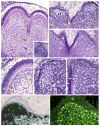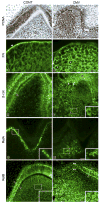Cytomegalovirus inhibition of embryonic mouse tooth development: a model of the human amelogenesis imperfecta phenocopy
- PMID: 18201685
- PMCID: PMC2279100
- DOI: 10.1016/j.archoralbio.2007.11.014
Cytomegalovirus inhibition of embryonic mouse tooth development: a model of the human amelogenesis imperfecta phenocopy
Abstract
Objective: Cytomegalovirus (CMV) is one of the most common causes of major birth defects in humans. Of the approximately 8400 children born each year in the U.S. with CMV-induced birth defects, more than 1/3 of these children exhibit hypoplasia and hypocalcification of tooth enamel. Our objective was to initiate the investigation of the pathogenesis of CMV-induced tooth defects.
Design: Mouse Cap stage mandibular first molars were infected with mouse CMV (mCMV) in vitro in a chemically-defined organ culture system and analysed utilising histological and immunolocalisation methodologies. The antiviral, acyclovir, was used to inhibit mCMV replication and comparisons made between mCMV-infected and acyclovir-treated, mCMV-infected teeth.
Results: Active infection of Cap stage molars for up to 15 days in vitro results in smaller, developmentally-delayed and dysmorphic molars characterised by shallow, broad and misshapen cusps, infected and affected dental papilla mesenchyme, poorly differentiated odontoblasts and ameloblasts, and no dentin matrix. Initial protein localisation studies suggest that the pathogenesis is mediated through NF-kappaB signaling and that there appears to be an unusual interaction between abnormal mesenchymal cells and surrounding matrix. Rescue with acyclovir indicates that mCMV replication is necessary to initiate and sustain progressive tooth dysmorphogenesis.
Conclusions: Our results indicate that mCMV-induced changes in signaling pathways severely delays, but does not completely interrupt, tooth morphogenesis. Importantly, our results demonstrate that this well-defined embryonic mouse organ culture system can be utilised to delineate the molecular mechanism underlying the CMV-induced tooth defects that characterise the amelogenesis imperfecta phenocopy seen in many CMV-infected children.
Figures



Similar articles
-
Cytomegalovirus induces abnormal chondrogenesis and osteogenesis during embryonic mandibular development.BMC Dev Biol. 2008 Mar 27;8:33. doi: 10.1186/1471-213X-8-33. BMC Dev Biol. 2008. PMID: 18371224 Free PMC article.
-
Cytomegalovirus induces stage-dependent enamel defects and misexpression of amelogenin, enamelin and dentin sialophosphoprotein in developing mouse molars.Cells Tissues Organs. 2010;192(4):221-39. doi: 10.1159/000314909. Epub 2010 May 18. Cells Tissues Organs. 2010. PMID: 20484882
-
Associations of FGF-3 and FGF-10 with signaling networks regulating tooth morphogenesis.Dev Dyn. 2000 Nov;219(3):322-32. doi: 10.1002/1097-0177(2000)9999:9999<::AID-DVDY1062>3.0.CO;2-J. Dev Dyn. 2000. PMID: 11066089
-
Enamel knots as signaling centers linking tooth morphogenesis and odontoblast differentiation.Adv Dent Res. 2001 Aug;15:14-8. doi: 10.1177/08959374010150010401. Adv Dent Res. 2001. PMID: 12640732 Review.
-
Developmental disorders of the mouse brain induced by murine cytomegalovirus: animal models for congenital cytomegalovirus infection.Pathol Int. 1995 Feb;45(2):91-102. doi: 10.1111/j.1440-1827.1995.tb03428.x. Pathol Int. 1995. PMID: 7742931 Review.
Cited by
-
Cytomegalovirus induces abnormal chondrogenesis and osteogenesis during embryonic mandibular development.BMC Dev Biol. 2008 Mar 27;8:33. doi: 10.1186/1471-213X-8-33. BMC Dev Biol. 2008. PMID: 18371224 Free PMC article.
-
Severe periodontitis and congenital cytomegalovirus: Cleft lip and cleft palate.Periodontol 2000. 2024 Oct;96(1):185-188. doi: 10.1111/prd.12606. Epub 2024 Sep 11. Periodontol 2000. 2024. PMID: 39262100 Free PMC article. Review.
-
Herpesvirus-bacteria synergistic interaction in periodontitis.Periodontol 2000. 2020 Feb;82(1):42-64. doi: 10.1111/prd.12311. Periodontol 2000. 2020. PMID: 31850623 Free PMC article. Review.
-
An in vitro mouse model of congenital cytomegalovirus-induced pathogenesis of the inner ear cochlea.Birth Defects Res A Clin Mol Teratol. 2013 Feb;97(2):69-78. doi: 10.1002/bdra.23105. Epub 2012 Dec 26. Birth Defects Res A Clin Mol Teratol. 2013. PMID: 23281115 Free PMC article.
-
Small molecule inhibitors of the host cell COX/AREG/EGFR/ERK pathway attenuate cytomegalovirus-induced pathogenesis.Exp Mol Pathol. 2011 Aug;91(1):400-10. doi: 10.1016/j.yexmp.2011.04.014. Epub 2011 May 1. Exp Mol Pathol. 2011. PMID: 21565184 Free PMC article.
References
-
- Pass RF. Cytomegalovirus. In: Knipe DM, Howley PM, Griffin DE, Lamb RA, Martin MA, Roizman B, et al., editors. Fields virology. 4th. Philadelphia: Lippincott Williams & Wilkins; 2001. pp. 2675–705.
-
- Dollard SC, Grosse SD, Ross DS. New estimates of the prevalence of neurological and sensory sequelae and mortality associated with congenital cytomegalovirus infection. Rev Med Virol. 2007;17:355–63. - PubMed
-
- Ross DS, Dollard SC, Victor M, Sumartojo E, Cannon MJ. The epidemiology and prevention of congenital cytomegalovirus infection and disease: activities of the Centers for Disease Control and Prevention Workgroup. J Womens Health (Larchmt) 2006;15:224–9. - PubMed
-
- Stagno S, Pass RF, Dworsky ME, Alford CA. Congenital and perinatal cytomegalovirus infections. Semin Perinatol. 1983;7:31–42. - PubMed
-
- Stagno S, Pass RF, Dworsky ME, Britt WJ, Alford CA. Congenital and perinatal cytomegalovirus infections: clinical characteristics and pathogenic factors. Birth Defects Orig Article Ser. 1984;20:65–85. - PubMed
Publication types
MeSH terms
Substances
Grants and funding
LinkOut - more resources
Full Text Sources
Miscellaneous

